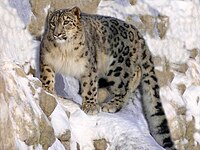
Photo from wikipedia
Abstract A treeline can respond to climate change by shifting position, infilling, increasing recruitment, and increasing radial growth. More studies from understudied areas and their associated species are needed to… Click to show full abstract
Abstract A treeline can respond to climate change by shifting position, infilling, increasing recruitment, and increasing radial growth. More studies from understudied areas and their associated species are needed to understand treeline structure and dynamics. We established two transects of 20 m width and 120 m length (100 m above and 20 m below the forestline) in the Betula utilis subalpine forest of the Dhorpatan Hunting Reserve in Western Nepal. All individuals of B. utilis within the transects were classified into three height classes – trees (>2 m), saplings (0.5–2 m), and seedlings (<0.5 m) – and measured for morphometric features. Tree-ring cores were collected for age structure analysis. B. utilis forms an abrupt treeline in the region, and the mean forestline and treeline elevations were 3893 and 3898 m, respectively. The average age (57 yr) of trees at the treeline ecotone suggests a young stand. Poor regeneration was observed above the forestline in both transects when compared to below the forestline. Low regeneration at the treeline ecotone suggests site-specific biotic and abiotic controlling factors. Seedling and sapling establishment above the forestline is limited by a lack of moisture, absence of suitable microsites, and presence of herbivores.
Journal Title: Physical Geography
Year Published: 2018
Link to full text (if available)
Share on Social Media: Sign Up to like & get
recommendations!